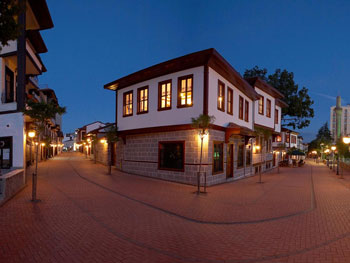Hamamonu: Difference between revisions
Filiz Ubay (talk | contribs) |
Filiz Ubay (talk | contribs) |
||
| Line 23: | Line 23: | ||
|} | |} | ||
Each year Turkey offers up its rich heritage, diverse culture and mysterious legends to visitors from all over the world. An unforgettable adventure awaits anyone who visits Turkey, and the capital, Ankara, is a popular choice for many holidaymakers. What you may not know is that Ankara also holds some of the country's best kept secrets; spectacular locations that are yet to be discovered. One of them is the Hamamonu district in Altındağ (meaning ''''old Ankara'''') in the middle of the city. Following a recent and remarkable res toration process, '''Hamamonu''' has reemerged as an attractive place to live in and visit. The district of '''Hamamonu''' is now a unique place that reflects both the traditional styles of the Ottoman Empire and the Turkish Republic. Located in the oldest part of the city, '''Hamamonu''' offers various leisure and shopping opportunities as well as cultural activities. | |||
'' | Regeneration and revival | ||
The regeneration of '''Hamamonu''' district became a priority for Ankara Cultural Tourism because of its historical interest and central location. Altındağ Municipality worked hard to restore the original charm of the district, attract inhabitants back and make it an interesting destination for tourists. Many buildings were reconstructed or completely rebuilt and several streets were pedestrianised. Since 2006, Hamamonu has seen restoration and expansion projects in 250 locations, including masjuds and mosques from the Seljuk era. An area of around 210 hectares was reconstructed and 33 sites were registered with the Cultural and Natural Heritage Preservation Board. Today, Hamamonu is a popular place for locals and tourists alike, its treasures and history unveiled for a new generation to enjoy. | |||
== Exercise 1: Sketching the Landscape == | == Exercise 1: Sketching the Landscape == | ||
Revision as of 18:16, 7 November 2011
---> back to overview of Case Study List
add long title of your theme
Each year Turkey offers up its rich heritage, diverse culture and mysterious legends to visitors from all over the world. An unforgettable adventure awaits anyone who visits Turkey, and the capital, Ankara, is a popular choice for many holidaymakers. What you may not know is that Ankara also holds some of the country's best kept secrets; spectacular locations that are yet to be discovered. One of them is the Hamamonu district in Altındağ (meaning 'old Ankara') in the middle of the city. Following a recent and remarkable res toration process, Hamamonu has reemerged as an attractive place to live in and visit. The district of Hamamonu is now a unique place that reflects both the traditional styles of the Ottoman Empire and the Turkish Republic. Located in the oldest part of the city, Hamamonu offers various leisure and shopping opportunities as well as cultural activities. Regeneration and revival The regeneration of Hamamonu district became a priority for Ankara Cultural Tourism because of its historical interest and central location. Altındağ Municipality worked hard to restore the original charm of the district, attract inhabitants back and make it an interesting destination for tourists. Many buildings were reconstructed or completely rebuilt and several streets were pedestrianised. Since 2006, Hamamonu has seen restoration and expansion projects in 250 locations, including masjuds and mosques from the Seljuk era. An area of around 210 hectares was reconstructed and 33 sites were registered with the Cultural and Natural Heritage Preservation Board. Today, Hamamonu is a popular place for locals and tourists alike, its treasures and history unveiled for a new generation to enjoy.
Exercise 1: Sketching the Landscape
Time frame: October 25 - November 15, 2011
Student activities:
- Creation of analytical drawings and sketches
- Presentation of results
Please upload a selection of your drawings/sketches/mental maps and add them to the image gallery
Sketches and Drawings
- Yourimagename.jpg
your image text
- Yourimagename.jpg
your image text
- Yourimagename.jpg
your image text
- Yourimagename.jpg
your image text
- Yourimagename.jpg
your image text
Exercise 2: Landscape Layers
Time frame: November 15 - 29, 2011
- Classical analysis: topography, open spaces, built, green, traffic and water structures on different layers. *Definition of zones with coherent character
- Description of this character.
Please publish your findings here
Exercise 3: Behaviour Patterns
Time frame: December 6 - 20, 2011
- How do people behave in this area? How do they use the space? What is important for them?
- Observation of study area, interviews with local people and mapping of use patterns.
- Preparation of short presentation
Please publish your findings here
Exercise 4: Communication Concepts
Time frame: December 19, 2011 - January 17, 2012
- Based on the different landscape assessment approaches students will develop a communication concept for their area of study
- Which measures would be necessary for enhancing the awareness for the area?
- Students are free to choose their method.
Please publish your findings here
Image Gallery
- Yourimagename.jpg
your image text
- Yourimagename.jpg
your image text
- Yourimagename.jpg
your image text
- Yourimagename.jpg
your image text
- Yourimagename.jpg
your image text
References
* Please make sure that you give proper references of all external resources used.
* Do not use images of which you do not hold the copyright.
* Please add internet links to other resources if necessary.
About categories: You can add more categories with this tag: "", add your categories
